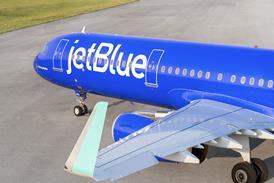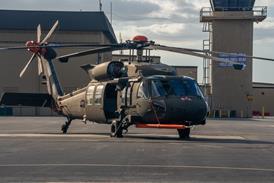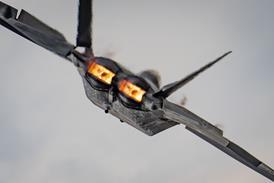
Ramon Lopez/WASHINGTON DC
With deployment of the Boeing Sikorsky RAH-66 Comanche not due until the next century, and a conceptual Joint Transport Rotorcraft (JTR) available no earlier than 2015, the US Army and various defence contractors are working to improve the safety, comfort and performance of current-generation military rotorcraft.
For example, an airframe de-tuning effort now under way at Boeing Helicopters is already being applied to the international Chinook programme, and cuts across other helicopter types, says Boeing. Benefits will also be seen in the US Army's $3 billion Chinook Improved Cargo Helicopter (ICH) programme, which involves structural, powerplant and cockpit upgrades to 300 ageing CH-47D heavy-lift helicopters.
In 1996, under a co-operative research-and-development agreement between Boeing and the US Army, a CH-47D was taken out of the Army fleet and sent to the US military-rotorcraft manufacturer for structural enhancements. The vibration-reduction test aircraft - the Bearcat 3 - has a "stiffened" airframe to tune out the vibration which cracks airframes, causes avionics to fail, and wears out crewmembers during long combat missions.
Most of the vibration in the CH-47D comes from three/rev and six/rev forces transmitted from the rotor hubs into the airframe below. Work to date has largely centred on the Chinook's forward door and forward transmission-support beams.
Airframe stiffening work which has taken place to date appears promising, and vibration-reduction flight testing conducted in 1997 at Fort Rucker, Alabama, continues this year. Vibration is now dampened on Chinooks with three active vibration absorbers which weigh a total of 266kg. It is still unclear whether some or all of the vibration suppressors can be eliminated in favour of extra payload or range.

TWIST AND SHOUT
Another continuing vibration and rotor noise-reduction R&D project involving Boeing and funded by the US Defense Advanced Research Projects Agency (DARPA) will not benefit the CH-47ICH, but could be applied to the Bell Boeing V-22 tilt-rotor, the JTR and other future US Army rotorcraft.
Late in 1997, DARPA awarded the Smart Materials and Structures Demonstration Consortium an $8 million contract to continue development of smart materials/actuators for next-generation rotor systems. The consortium includes Boeing units in Seattle; Mesa, in Arizona; and Philadelphia, together with the Pennsylvania State University and Massachusetts Institute of Technology (MIT).
The 52-month Phase 2 contract brings together the three Boeing units which had been working separately under Phase 1. Boeing Helicopters and Boeing Seattle Research and Technology led the Smart Structures for Rotor Control (SSRC) cost-sharing effort while McDonnell Douglas Helicopter Systems - now Boeing Mesa - conducted the Smart Material Actuated Rotor Technology (SMART) Blade project. (DARPA had decided to merge the parties for Phase 2 even before Boeing's merger with McDonnell Douglas was finalised).
Boeing officials say that a rotor blade which can alter its twist distribution in flight "holds great promise, since choosing a twist distribution is one of the fundamental compromises the helicopter designer faces".
The most efficient designs for hover require high power and cause excessive vibration in high-speed cruise. A highly twisted blade is desirable for hover, but will be difficult to trim in forward flight, when the advancing blade produces more lift than the retreating blade is capable of countering, they add.
SMART MATERIALS
The Boeing/MIT rotor system holds the promise of actively altering blade twist in flight. It uses "smart materials" embedded in the rotor blade to produce a twisting moment, which can be controlled by altering the electrical voltage applied to the material.
The system for twisting the blade uses a form of piezo-fibre composites. These are embedded in an epoxy matrix along with glassfibre-reinforced-plastic fibres, and are actuated by "interdigitated" electrodes.
The material has existed for some time, but the quality was inadequate for this application. Phase 1 R&D involved development of better material and the actuators.
The SSRC effort also included work on trailing-edge flap actuation, using smart materials, which, in a different way, would improve rotor-blade performance. Fabrication of a 1/6-scale "smart" CH-47 rotor blade for test on a hover stand at MIT is envisioned for Phase 2.
Boeing Mesa, meanwhile, continues the SMART Blade research effort, which involves development of "smart" trim tabs and a different concept for trailing-edge flap actuation. Boeing Seattle and the Naval Ordnance Laboratory, on the other hand, have developed Nickel-Titanium-Shaped-Memory-Allow-Material (NITINOL) for the same application.
Within four months, the team members will meet to compare test results and decide on which technology to pursue during the rest of Phase 2. They will also pick the flight-demonstration aircraft, either the two-bladed Ultrasport 496 kit helicopter made by American SportCopter, or the five-bladed Boeing MD 900 Explorer.
Boeing officials believe that the NITINOL R&D can be applied to the V-22 tilt-rotor. The company hopes that the US Navy will initiate an advanced-technology demonstration for the V-22 enhancement, beginning in fiscal year 2000. They eye an improvement of 15% in range and 10% in payload. The rotor blade's weight would increase by 10%, but no drive-train upgrade would be required, they add.

HACT AROUND- Another application of the DARPA-sponsored research is the soon-to-be-launched Helicopter Active Control Technology (HACT) programme. The US Army's Aviation Applied Technology Directorate is expected to issue a request for proposals in March for research contracts to run between FY1998 and FY2003.
The plan is to incorporate active control and smart-material analytical models into a comprehensive rotor analysis in FY1998, followed by demonstration of active swashplate stability-augmentation in FY1999. During FY2002, low-vibration/noise high-performance rotor tests with active control would be conducted, followed by integration of advanced rotor technology with a test aircraft for system studies in FY2003.
The HACT programme is also designed to explore innovative methodologies and concepts in rotorcraft aeromechanics, structural dynamics and smart materials. The programme will provide for technology insertion into the CH-47, RAH-66, Boeing AH-64 and Sikorksy UH-60. Looking further ahead, the effort will support future US military rotorcraft such as the JTR and the Future Attack Aerial Vehicle, as well as Multi-Role Mission Adaptable Air Vehicle.
The concepts under study are considered "leap-ahead" technologies, and "the first step towards an all-electric blade", say Boeing researchers. "In the long run, it could start replacing upper boost actuators and perhaps, eventually, the swashplate. "That's the Holy Grail that we're shooting for," says one Boeing official.
Citing potential weight and cost savings and reduced rotor-system complexity, the officials say: "This is a technology worth pursuing on a dollars-and-cents argument alone. While the long-term benefits associated with quieter and smoother-riding rotorcraft may be intangible, the short-term productivity improvements which this technology enables justifies its cost."
VEHICLE FOR THE FUTURE
The future Joint Transport Rotorcraft (JTR) would be used by all branches of the US military, and a civil freighter/commuter aircraft is envisioned. A conceptual air-vehicle configuration has not yet been selected, however.
The JTR is destined to replace the CH-47ICH and the Sikorsky CH-53E, MH-53E and HH-60G. Early estimates indicate that more than 750 JTRs will be required to fulfill US Department of Defense requirements.
The US Army supports an advanced- technology demonstration of JTR components, beginning in fiscal year 2000. JTR design efforts would follow the demonstration, with prototype fabrication and flight testing scheduled for completion in FY2014. The first production aircraft would be delivered in FY2015.
The Multi-Role Mission Adaptable Air Vehicle (MRMAAV) would be used for multiple missions, such as reconnaissance and light attack. Given a limited number of aircraft in a future combat zone, the MRMAAV would be used to conduct "operations-of-the-day" through use of interchangeable mission equipment packages.
The US Army plans to evaluate a flying MRMAAV demonstrator in the field. A technology demonstration is tentatively scheduled to run between FY2007 and FY2011. US Army aviation officials see the MRMAAV as the eventual replacement for the Boeing AH-64D and/or Boeing Sikorsky RAH-66.
Meanwhile, the Airborne Modular Unmanned Logistics Express would be an automated air vehicle, providing logistical movement of modular loads weighing as much as 4,540kg. Design efforts are planned to begin in FY2007, with flight tests concluding in FY2010.
Source: Flight International























